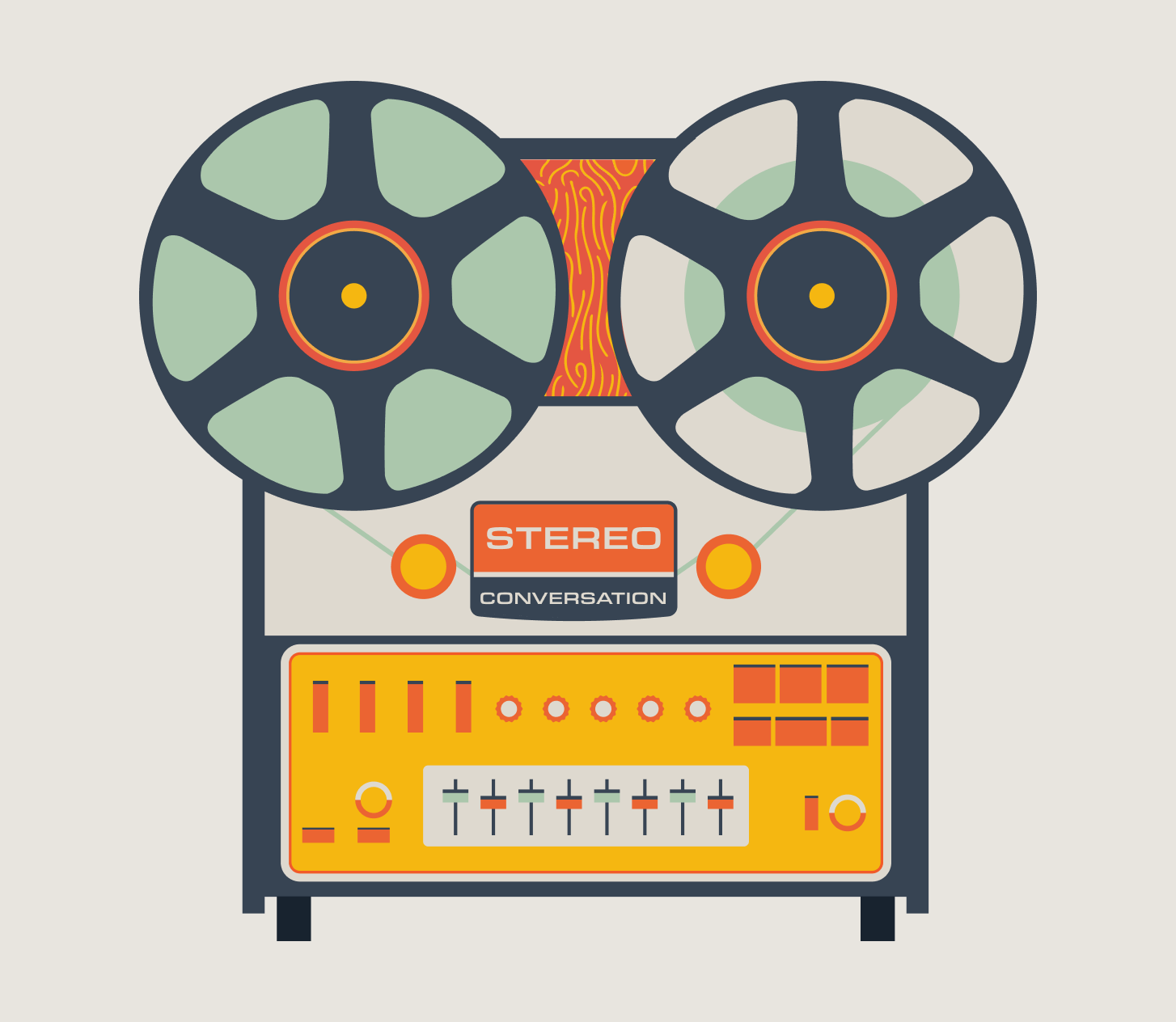
When I was sixteen I convinced my mom to buy me a Sony M-560V Microcassette Recorder. I pitched it as a way to listen back to myself playing drums in the school high school jazz band, but instead I ended up using it to record interesting conversations overheard at school or the local flea market.
Soon after, I came across the opportunity to start writing music criticism for a blog some folks were starting up in Iowa and I realized that this handheld recorder was my ticket to talking to musicians, artists, and other cultural figures I admired. I could initiate a conversation instead of simply eavesdropping. Cultivating this seemingly simple practice has informed the way I react with coworkers, management, clients, and stakeholders in nearly every aspect of my professional life.
My first assignment was to interview Calvin Johnson, founder of K Records and key member of two of my favorite bands at the time (Beat Happening and The Halo Benders). I created a tight list of questions, leaning into my teenage brain’s confidence in its own abilities. I tested my recording device, placed the call, and made it five minutes until I turfed.
The question that snagged me? “What is one project that you’ve regretted being a part of?” In my mind, this was hard-hitting journalism. No fluff here, just hot takes. His response was simple, “None of them, because they all involved other people that cared about them.” He could tell that had thrown me, and he spent the next ten minutes giving me interview etiquette pointers that he had accumulated from his days at KAOS radio in Olympia, including how important it was to slow down when asking a question and the importance of allowing conversational space for a-ha moments. It was a kind, generous way to tell me to shut up and listen. The advice didn’t immediately stick, but it put me on the right path.
In the years since, I’ve interviewed a number of people in different capacities, and I’ve tried my best to get better at listening. Within the professional world, and especially in the niche of project management, this is an essential skill that’s often overlooked or dismissed. The tone and tenor of a conversation can help smooth out a rocky start to a project with a new team or help safely guide you through rough waters mid-project.The reality is that learning to listen and follow the stream of a conversation can lead to innovation, solutions, and a rapport that’s essential to being a custodian of good work.
Active Listening
One of the best ways to crack any conversation is the open-ended question. This isn’t the same as small talk (which is often still helpful in situations where you need to find an email, dissociate, or plan a swift exit), but rather something more along the lines of a prompt that allows inroads into the thought patterns of your conversation partner. Often with a client, this is when hidden concerns can begin to surface. Have they had a rough experience with a certain component of development or design before? Anticipate and reassure them about things in casual conversation before they have the chance to address them directly. This lets folks know that you’re listening, acknowledging, and grants them the kindness of being heard. Doing this skillfully and being flexible with where your follow up questions lead can bring you closer to critical next steps.
Building a Rapport
Sometimes this happens naturally, other times it requires delicate pruning, and the rest of the time you’re faking it until you’ve made it out unscathed. A rapport (or even the sense of one) allows a person, client, etc. to speak more openly about their concerns, ideas they’re a bit shy about, or share critical pieces of organizational information with you that might otherwise be held close to their vest. As a rule, when I’m engaging with someone on the ground floor and hoping to build a level of comfort in the conversation, I come in unarmed. I do not care if they’re a CEO, a criminal, an important artist, or a person answering a quick opinion question on the street. I just need them to feel comfortable enough being themselves that they can take a beat and express what they need to share.
Once you crack that surface, you can really start rolling. I recall when I was 19 and interviewing alt-country musician Neko Case, I was totally starstruck and struggled to recover from an initial set of droll album-oriented questions. I shook it off and brought up a lyric from a deep cut on her Canadian Amp EP about hitting a deer with her car. It turned out that she had spent part of her childhood in rural Virginia and we were quickly off to the races with wildlife in urban settings, favorite authors, and anthropomorphism in her own work. It can work the same way with a client. Just because a question seemingly has nothing to do with the project at hand doesn’t necessarily mean that it’s not relevant to the work in a way that you can’t anticipate. You won’t know until you ask.
Non-Verbal Communication
Non-verbal communication is a critical tool that can be out of reach to folks who are working in a virtual environment. As much as Silicon Valley would like us to believe that we can fully transcend our physical bodies and articulate ourselves in a digital space, this concept works better in a pitch deck to shareholders than in reality. When a client or coworker is lethargic, reluctant, or simply not on the same wavelength, try being more physically expressive and lean into the situation.
There are some (hopefully) obvious limits to this, but attempt to convey enthusiasm. On the other side of this, if you’re dealing with sensitive topics, try to create a warm, safe space for the conversation to bloom. When I’ve done interviews with people who are in recovery from substance abuse, domestic violence, or experiencing homelessness, I try to leave enough space in our conversation to receive big feelings. Sometimes this is as simple as leaning in, giving affirmative nods, and maintaining eye contact. It’s important to recognize that for some people it’s rare that they get the space to convey their experience with someone who is actively interested in their story. This same approach can be applied to a frustrated or misunderstood client, or a coworker who is working through a challenge that they’ve either not fully processed or felt comfortable articulating.
Validation
At one time in my life, I worked to organize conferences and training seminars for psychologists that were focused on teaching validation therapy to treat elderly patients with dementia. I later left that position for a more lucrative gig analyzing case histories and interviews for a forensic and clinical psychology firm. My time in both of these positions taught me how essential it was to listen to and accept the worldview of those you are engaging with, regardless of your personal alignment with it.
In both cases, even the most difficult of patients would begin to open up once they were acknowledged in a way that didn’t attempt to minimize their subjective reality. This was easily the toughest lesson for me to internalize, because as humans we often have a deep need for others to understand and accept where we’re coming from, and letting go of that takes practice. With clients, stakeholders, etc., I learned that I don’t need to modify my worldview to accommodate them, I just need to step into their shoes long enough to understand how to connect them with my vision of an ideal outcome that will satisfy their perceived needs as well as the goals of the project. Sometimes this can mean beginning your responses with “what I’m hearing from you is” or simply acknowledging their frustration with an “I can see” statement.
Conclusion
There are countless ways someone can try to manipulate a situation for desired results, but empathy, allowing for differing perspectives, and accepting the possibility of being wrong enriches interactions and can often provide a new path to success. A year or so ago, I encountered a client who was walled off and blamed other stakeholders for a project being blocked. During some downtime on one of our calls, I asked what her core frustrations were in the project. Her reply was simply that she wasn’t being heard. By acknowledging that and moving past it, the challenges that seemed insurmountable lifted, and the tenor of our team conversations changed dramatically. Sometimes you just have to let it roll and keep a keen ear.
Loved the article? Hated it? Didn’t even read it?
We’d love to hear from you.




